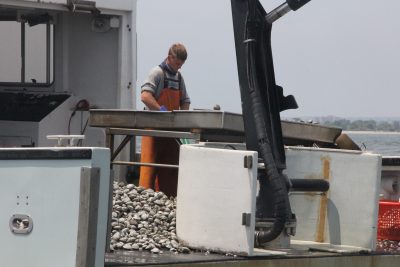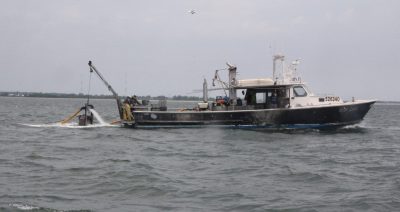
Story and photos by Judy Benson
Connecticut shellfish farmers endured the precipitous sales losses that nearly shut their businesses down during the early days of the pandemic last spring.
Now, as their normally slow winter season approaches, oyster growers like Dave Hopp, Steve Plant and Larry Fernandez are preparing to weather what could be even tougher months ahead, with fresh influxes of federal and state funding coming just when they’re going to be needing it most.
“We’ve got to get through this,” said Hopp of Bell’s Shellfish, a company he owns with his two grandsons that harvests oysters and clams from the waters of Long Island Sound offshore from Norwalk and Bridgeport.
For the first time this summer, Bell’s Shellfish and several other companies sold their oysters and clams directly to customers at outdoor markets and breweries. As colder temperatures descend, Hopp’s grandson Robert Norrholm is looking to do home deliveries of shellfish for the holidays.
“As of right now, we’re just keeping our heads above water,” he said. State and federal assistance they received has been critical.
Connecticut Cultured Oysters owner Steve Plant survived the near total loss of his restaurant sales by shucking and selling fresh oysters himself seven days a week at Ford’s Lobsters, a seasonal outdoor eatery next door to the Noank docks where he keeps his boats, along with income from his wife Jill’s farmers market sales. While Jill Plant can continue selling at the indoor winter farmers market, the end of the outdoor dining season has Steve Plant hoping the modest rebound of wholesale restaurant orders he’s been seeing will continue. But he’s keenly aware a further surge in COVID cases could shut indoor dining again.
“Nobody knows whether we’re going to find ourselves back in the same situation we were in last spring,” he said.
He already dipped into his savings and “tightened his belt” to get through the spring and summer. Now, he and other shellfishermen are awaiting financial assistance from new federal and state programs from the SBA, USDA, NOAA and Connecticut CARES small business grants.
“Those programs weren’t available during the worst of the crisis in the spring,” he said. “But they may be coming along now when it’ll be beneficial for us going into the winter.”
Tessa Getchis, aquaculture extension specialist for Connecticut Sea Grant, said that the state’s $30 million shellfish industry wouldn’t have been able to survive without the various state and federal assistance programs that many – but not all – shellfishermen have tapped so far. These ranged from the Paycheck Protection Program and others broadly available, to those that specifically targeting shellfish farmers. CT Sea Grant worked with the state Department of Agriculture Bureau of Aquaculture to facilitate direct market sales, make shellfishermen aware of financial assistance and identified innovative ways for the farmers to earn income while markets were closed.
“It quickly became clear that any one government program was not going to be enough to make businesses whole, so while we were informing the industry about types of funding that were available we were also working together to justify the need for further funding,” Getchis said.
Lack of cash flow was the first major threat to the industry. With wholesale markets closed, businesses had no way to keep their employees working and on the payroll.
In the immediate aftermath of the pandemic shutdown, CT Sea Grant surveyed shellfishermen to document their sales losses of up to 90% and layoffs of 270 workers. Then Sea Grant and the Bureau of Aquaculture responded with a three-part program that put the farmers and their crews back to work rehabilitating more than 1,800 of the state’s 7,000 acres of natural shellfish beds in western Long Island Sound. Workers from about two-thirds of the shellfish companies were employed to clean the beds and plant shell and live oysters to improve the habitat for larval oysters that are the main source of seed crop for the shellfish growers.
“This will have long-term benefits,” said Hopp, who worked on the beds for about seven weeks in the spring and summer with his crews. “It was really satisfying to see all the shellfishermen working together. Those natural beds are really key to the industry.”

In addition to cash payments for the enhancement work, shellfishermen were also compensated with clams they were able to harvest and sell from the natural beds. Larry Fernandez, owner of an oyster company in Bridgeport, participated in a third part of the project. He sold the state 500 bushels of oysters from his beds that had grown too large for consumer markets. His oysters were planted on closed portions of the natural beds to expand the foundation for future crops.
Fernandez and other shellfishermen have been spending as much time as possible in late fall on their boats seeding their future crops in hopes of better days ahead.
“I have to stay two years ahead,” he said. “If there’s no cash flow, you won’t have the funds to seed.”
Getchis credits the collaborations between state agencies, NOAA and USDA officials and the CT Congressional delegation who “tirelessly fought for our farmers to be eligible for additional funding.” Without it, Connecticut might have lost its historic shellfish industry.
They reached out to better understand the magnitude of the losses, visited farms to learn first-hand about their situation and wrote letter after letter to advocate for funding. Getchis said. Their efforts paid off, and at an Oct. 19 visit to the Noank Aquaculture Coooperative, Gov. Ned Lamont, Rep. Joe Courtney and other officials met with farmers to announce that the USDA CARES Act funding (the largest pool of funding available to farmers) was expanded to include shellfish aquaculture.
“Shellfish farmers are not people who like taking a handout, but now it’s about their survival,” Getchis said. “They’ve already used up their savings, and we know that no one pot of money was going to be enough.”
Connecticut Sea Grant and the state Department of Agriculture have already begun working on obtaining additional funding for a second round of natural bed rehabilitation work for the industry.
“I have confidence the industry will rebound,” Getchis said. “They are the hardest working people I know – passionate, purposeful, persistent.”
More information:
- Financial assistance programs for shellfish farmers: https://shellfish.uconn.edu, click “Financial Resources.”
- Connecticut seafood direct sales and retail locations: https://shellfish.uconn.edu/seafood-sales/
- “Project expands support for shellfish industry” https://seagrant.uconn.edu/?p=6462
Judy Benson is the communications coordinator for Connecticut Sea Grant.